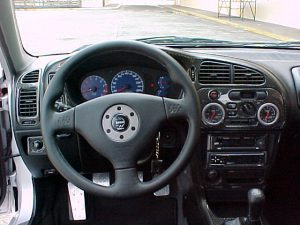Following the extinction of the GroupB rally cars, FIA introduced devices known as turbo restrictors in order to limit the maximum output of turbocharged engines. These are to be applied to all GroupA, WRC and GroupN vehicles taking part in FIA competitions. FIA explains the introduction of turbo restrictors with safety reasons. Like many other FIA decisions this an unfortunate one. Most rally drivers are complaining that the cars are less easy to drive with these devices fitted since the chassis handling capacity is under-exploited. Most of the negative effects of turbo restrictors are efficiently addressed by electronic engine management systems.
A turbo restrictor is essentially a tube fitted directly on the turbocharger’s air intake. We will not go into very technical (bureaucratic) details on their geometry but their main purpose is to reduce the turbine’s air intake flow and, consequently, its output. The internal diameter of the restrictor is being continually reduced by FIA regulations from 38mm (1992) to 36mm (1994) to 34mm (1995) and now 32mm on GroupN cars (the 34mm restrictor still applies to GroupA cars). Turbo restrictors also increase the turbo’s lag time but most teams overcome this effect by fitting anti-lag systems.
The turbo restrictor’s effect is mostly noticed in high engine RPM (above 5000). In this region of operation, the engine’s output is very dependent on air flow. This is why engine heads are ported and air intake channels are polished to optimize air flow. The restrictor’s effect on engine torque is beneficial. Peak torque values are obtained in medium engine rotational speeds. The presence of the restrictor, which actually accelerates the gases flowing through it and directs the air flow to the center of the turbocharger’s compressor wheel, essentially increases the engine torque. We can roughly estimate the drop in engine power to be as high as 40% whereas the engine torque can be increased, through appropriate engine management, by around 20%.
The use of the restrictor not only has negative effects on the engine’s output but also introduces other side effects. For instance the technology research applied to the mechanical parts racing engines is now almost pointless. Engineers try to find ways to optimize the engine’s output by optimizing its electronic management rather than the engine internals. Rally car racing engines are less sophisticated, mechanically, than they might have been if the FIA didn’t impose the use of restrictors. Since most rally cars are based on commercial vehicles the latter are available with engines that are also less interesting mechanically.

